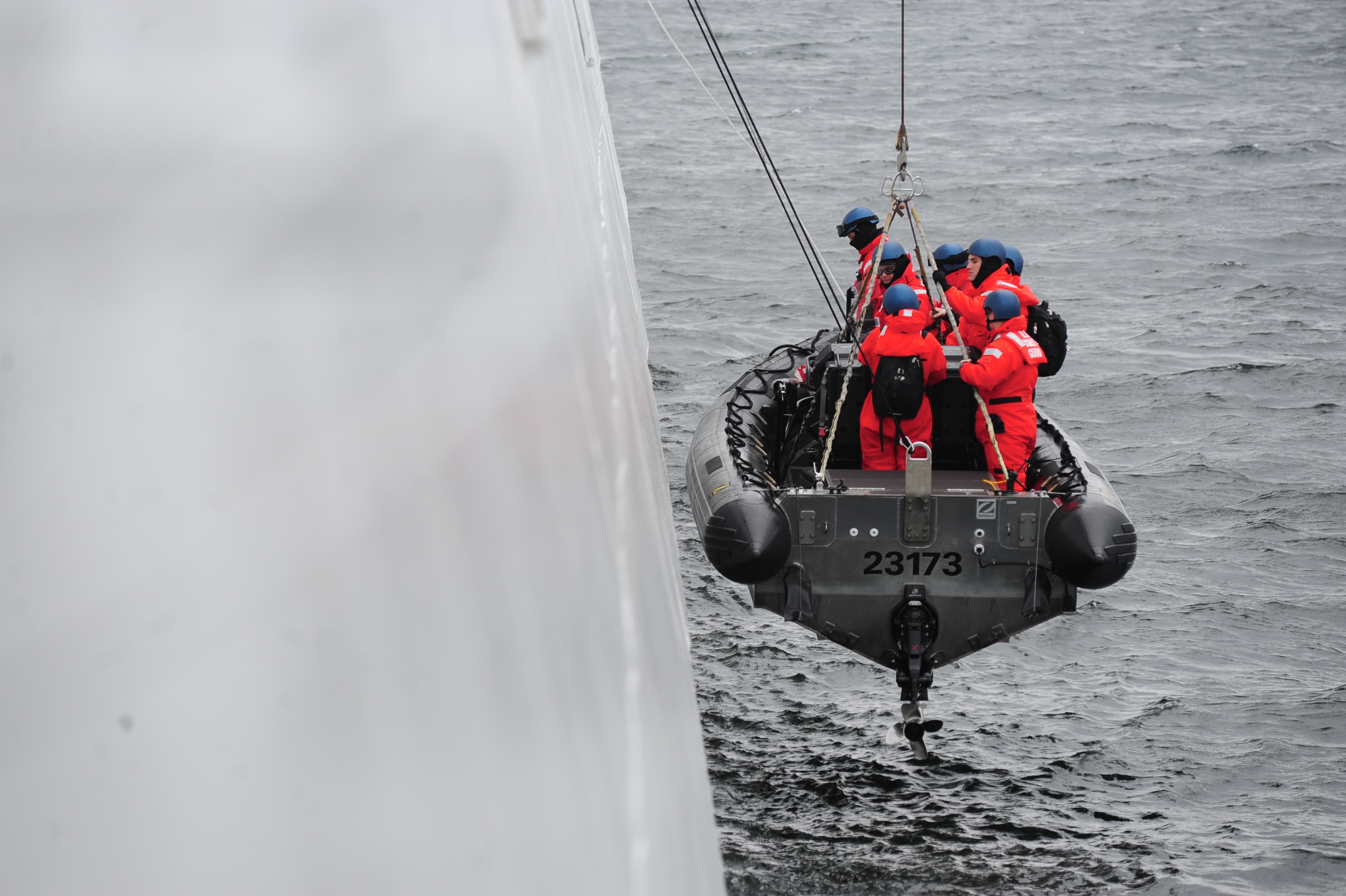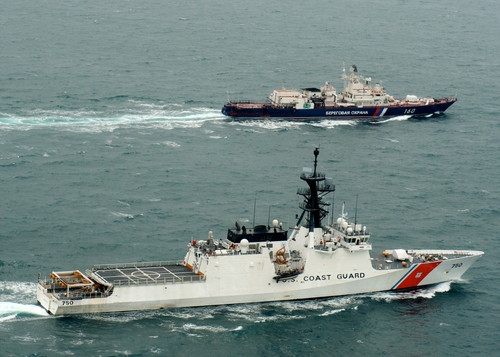From the bridge of the Bertholf: A word from the commanding officer
Monday, May 9, 2011
Posted by: LTJG Stephanie Young
As one of the Coast Guard’s newest assets, the national security cutters bring operational capabilities the fleet needs for mission success. Compass has asked the wardroom of Coast Guard Cutter Bertholf, the service’s first NSC, to share their unique perspective on how the fleet’s newest class of cutters will perform in the world’s most challenging operating environments, and this week’s update comes from the ship’s commanding officer, Capt. John Prince. You can also also stop by Coast Guard Alaska for the view from the deck plate, focusing on Bertholf’s day to day operations that make their missions a success.

Coast Guard Cutter Bertholf meets heavy seas in the Bering Sea. U.S. Coast Guard photo by Petty Officer 3rd Class Jonathan Lally.
Written by Capt. John Prince, commanding officer, Coast Guard Cutter Bertholf.
Greetings from the Bering Sea. We’ve been underway for more than a month on the first Alaska patrol for a national security cutter, and I can say it has been a truly impressive performance by the ship and our crew.
We’ve experienced 20-foot seas and winds in excess of 60 knots with temperatures below freezing, and despite these sea conditions the ship has remained within pitch and roll limits to launch our helicopter. We have been able to make a comfortable 12 to 15 knots through the water in seas up to 14 feet, validating the sea keeping and stability of the NSC and our ability to respond quickly to any emergency.
Our 12,000 nautical mile range at economical speed, and 8,000 nautical mile range at a speed of 14 knots has allowed us to remain at sea for more than 24 days at a time and cover large swaths of the ocean with our sensors and helicopter, while still maintaining a fuel reserve in the event of emergency.

Coast Guard Cutter Bertholf has two ways to launch their small boat - one from the side and one from the stern. Here, a boatcrew is launched from the side davit. U.S. Coast Guard photo by Petty Officer 3rd Class Jonathan Lally.
Keeping our stability well within safe limits without concern over low fuel levels, our installed ballast tanks help us to better preserve and protect the marine environment as we are not ballasting tanks that previously held fuel like on the 378-foot high endurance cutter.
Our boarding teams have conducted close to 20 safe and effective fisheries law enforcement boardings in seas up to eight feet, on vessels ranging from 58 feet to more than 200 feet, ensuring the fishing fleet is safe and earning their living in accordance with U.S. rules and regulations. Our helicopter has conducted more than a dozen flights observing the fishing fleet and remains at the ready for medevac and provisioning.
When most folks think of ALPAT they immediately have visions of rough weather, bitter cold and dramatic rescues as captured on the “Deadliest Catch.” That certainly is a part of this mission, but by no means captures its depth and scope.
ALPAT is a 365 days a year national sovereignty, economic security, living marine resource protection and search and rescue mission that encompasses hundreds of thousands of square miles of the North Pacific and Arctic Ocean, thousands of miles of coastline and hundreds of marine sanctuaries and other protected areas. As the long maritime arm of the Department of Homeland Security, we guard our international maritime boundaries and exclusive economic zones responding to incursions by foreign fishing vessels and others who should not be in our waters to ensure the security of our homeland and protection of our natural resources.

Petty Officer 1st Class Ryan Humphrey, a boatswain's mate aboard Coast Guard Cutter Bertholf, prepares to launch a small boat from the stern of the ship. U.S. Coast Guard photo by Petty Officer 3rd Class Jonathan Lally.
In partnership with other federal, state tribal and local agencies, we ensure that fishing activities are conducted in accordance with the rules and regulations that not only govern how fishing is conducted, but also where, when and how much fish can be harvested to ensure a sustainable fish population that is vital to our national and economic security.
More than 60 percent of the United States’ commercial seafood harvests come from Alaska, with more than five billion pounds of fish and shellfish harvested annually. The resources we are protecting are extremely valuable and as we have seen in other countries, once the stocks are depleted the fish don’t return. We patrol and observe Stellar sea lion rookeries and other critical marine habitats and preservation areas to protect and preserve endangered species and the natural beauty of Alaska. And, as seen on TV, we battle oftentimes harsh sea conditions to safeguard our fellow citizens from the perils of the sea and one of the most dangerous U.S. professions – commercial fishing.
This is no easy task, and it takes a highly capable ship and crew, equipped with the right tools, command and control systems, onboard sensors, information exchange and weapons systems. The ship must be able to get on scene quickly, maintain continuous presence for extended periods, monitor the areas with sensors and carry out the mission using a variety of tools such as small boats and helicopters. And it must be able to do all these things in both fair and foul weather.
From what I have observed on this patrol, and during previous patrols on Bertholf as far south as South America, the national security cutter is that ship and more. And as our fleet of high endurance cutters that diligently conducted this mission for the past four decades are retired, the national security cutter will be the right ship in the Coast Guard fleet to safely and effectively carry out these missions.

The crew of Coast Guard Cutter Bertholf and the Russian Federal Security Service frigate Vorovsky sail west for a joint effort April 21, 2011. The crews of the two ships are participating in a cultural exchange sharing training and best practices for several types of missions. U.S. Coast Guard photo by Petty Officer 1st Class Sara Francis.
It is truly exhilarating as a sailor and cutterman to see what this optimally crewed ship is capable of – fast, quiet, a good ride, environmentally friendly, top notch sensors, weapons systems and communications suite, a huge and stable flight deck, interoperable with Department of Defense and other partners. Just recently, we demonstrated U.S. capabilities and commitment to preserving the balance in the Arctic region when we worked with our Russian partners. They were impressed with the high morale and quality of life enjoyed by our crew from berthing areas to the exercise facility to our galley – which was recently selected as the dining facility of the year in the large afloat category for its quality and efficiency. Other than good weather and calm seas, there is not much more I could ask for.
We are learning new and more efficient ways to do things each and every day, and the contributions the national security cutter is making to the Coast Guard, the Department of Homeland Security and our nation will only grow as the days go by. We look forward to continued adventures and success standing a taut watch on the Northern Front, and will share those stories with you as they unfold.
Capt. John Prince is commanding officer of Coast Guard Cutter Bertholf. This is his eighth afloat tour and sixth afloat command. Prior to Bertholf, Prince commanded Coast Guard Cutter Jarvis, a 378-foot high endurance cutter, and completed three Alaska patrols with that ship and crew. He has 26 years of service and more than 16 years afloat on seven different classes of Coast Guard cutters.

Coast Guard Cutter Bertholf's crew and an HH-65 Dolphin helicopter crew conduct an inflight refuel. U.S. Coast Guard photo by Petty Officer 3rd Class Jonathan Lally.
Tags: Alaska, alaska patrol, ALPAT, Bertholf, CGC Bertholf, fisheries, From the bridge of the Bertholf, John Prince, national security cutter, NSC, Security
Comments
Leave a Comment
We welcome your comments on postings at all Coast Guard sites/journals. These are sponsored by the U.S. Coast Guard to provide a forum to talk about our work providing maritime safety, security and stewardship for the American people to secure the homeland, save lives and property, protect the environment, and promote economic prosperity.
The information provided is for public information only and is not a distress communication channel. People in an emergency and in need of Coast Guard assistance should use VHF-FM Channel 16 (156.8 MHz), dial 911, or call their nearest Coast Guard unit.
All comments submitted are moderated. The Coast Guard retains the discretion to determine which comments it will post and which it will not. We expect all contributors to be respectful. We will not post comments that contain personal attacks of any kind; refer to Coast Guard or other employees by name; contain offensive terms that target specific ethnic or racial groups, or contain vulgar language. We will also not post comments that are spam, are clearly off topic, or that promote services or products.
The U.S. Coast Guard disclaims any liability for any loss or damage resulting from any comments posted on this page. This forum may not be used for the submission of any claim, demand, informal or formal complaint, or any other form of legal and/or administrative notice or process, or for the exhaustion of any legal and/or administrative remedy.
If you have specific questions regarding a U.S. Coast Guard program that involves details you do not wish to share publicly please contact the program point of contact listed at http://www.uscg.mil/global/mail/
The U.S. Coast Guard will not collect or retain Personally Identifiable Information unless you voluntarily provide it to us. To view the U.S. Coast Guard�s Privacy Policy, please visit: http://www.uscg.mil/global/disclaim.asp
Please note: Anonymous comments have been disabled for this journal. It is preferred that you use your real name when posting a comment. WE WILL POST THE NAME YOU ENTER WHEN YOU SUBMIT YOUR COMMENT. Also, you are welcome to use Open ID or other user technologies that may be available.


Thank you Captain for your informative and encouraging article on the performance of the crew and the impressive USCGC Bertholf. It is great news to know that the ship is performing as well, if not better than anticipted. I have seen the Bering Sea at it’s best and it’s worse. As a veteran of 13 Bering Sea Patrols on four different high endurance cuttters I can’t say I envy your important role in those conditions that you have to contend with, but admire you for taking it on like a trooper. Semper Paratus and Bravo Zulu to you and your crew.
If the CG had a “Chamber of Commerce” for Cutterman you’d have to add the Captain’s post. Very encouraging to hear how well the crew is sailing and working their new and very capable ship.
Thank you BERTHOLF for your service!
Nice to see that as you take a new cutter into the open ocean you take a proud history and tradition with you.
Captain Prince: Thanks for the great article on BERTHOLF’s Bering Sea deployment! I just returned from testifying before our Senate Appropriations Subcommittee on the FY 2012 budget, and I was able to work some of your comments and observations into my responses to NSC questions. This information was very timely, and made a big impact.
All my best to my BERTHOLF Shipmates!
Admiral Papp